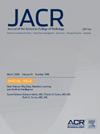冠状动脉异常的ACR适宜性标准评估
IF 5.1
3区 医学
Q1 RADIOLOGY, NUCLEAR MEDICINE & MEDICAL IMAGING
引用次数: 0
摘要
冠状动脉的先天性异常通常是偶然发现的,但在急性心脏症状的背景下。冠状动脉异常的处理和决策途径在很大程度上依赖于影像学来确定异常的类型,其临床意义,并最终计划任何手术干预。如果不需要进一步的干预,成像也为患者提供指导,观察管理是正确的选择。成像也允许在手术或干预中预测潜在的高风险情况,通过确定患者在压力下已经引起缺血的高风险特征。总之,心脏成像决定、指导和安慰患者和医生处理先天性冠状动脉异常。美国放射学会适当性标准是针对特定临床条件的循证指南,每年由多学科专家小组审查。指南的制定和修订过程支持对同行评议期刊的医学文献进行系统分析。已建立的方法原则,如建议分级评估,发展和评估或GRADE适用于评估证据。兰德/加州大学洛杉矶分校适当方法用户手册提供了确定特定临床情况下成像和治疗程序的适当性的方法。在同行评议文献缺乏或模棱两可的情况下,专家可能是制定建议的主要证据来源。本文章由计算机程序翻译,如有差异,请以英文原文为准。
ACR Appropriateness Criteria® Evaluation of Coronary Artery Anomalies
Congenital anomalies of the coronary arteries are often discovered incidentally yet in the context of acute cardiac symptoms. The management and decision-making pathway of anomalous coronary arteries relies heavily on imaging to determine the type of anomaly, its clinical significance, and ultimately to plan any surgical interventions. Imaging also provides guidance for patients if no further interventions are needed, and watchful management is the right choice. Imaging also allows to anticipate potential high-risk scenarios during surgery or intervention by determining patients with high-risk features that already cause ischemia during stress. In summary, cardiac imaging determines, guides, and reassures patients and physicians in the managements of congenital coronary anomalies.
The American College of Radiology Appropriateness Criteria are evidence-based guidelines for specific clinical conditions that are reviewed annually by a multidisciplinary expert panel. The guideline development and revision process support the systematic analysis of the medical literature from peer reviewed journals. Established methodology principles such as Grading of Recommendations Assessment, Development, and Evaluation or GRADE are adapted to evaluate the evidence. The RAND/UCLA Appropriateness Method User Manual provides the methodology to determine the appropriateness of imaging and treatment procedures for specific clinical scenarios. In those instances where peer reviewed literature is lacking or equivocal, experts may be the primary evidentiary source available to formulate a recommendation.
求助全文
通过发布文献求助,成功后即可免费获取论文全文。
去求助
来源期刊

Journal of the American College of Radiology
RADIOLOGY, NUCLEAR MEDICINE & MEDICAL IMAGING-
CiteScore
6.30
自引率
8.90%
发文量
312
审稿时长
34 days
期刊介绍:
The official journal of the American College of Radiology, JACR informs its readers of timely, pertinent, and important topics affecting the practice of diagnostic radiologists, interventional radiologists, medical physicists, and radiation oncologists. In so doing, JACR improves their practices and helps optimize their role in the health care system. By providing a forum for informative, well-written articles on health policy, clinical practice, practice management, data science, and education, JACR engages readers in a dialogue that ultimately benefits patient care.
 求助内容:
求助内容: 应助结果提醒方式:
应助结果提醒方式:


